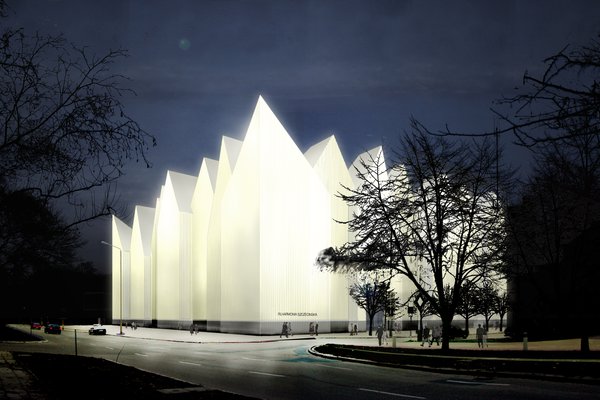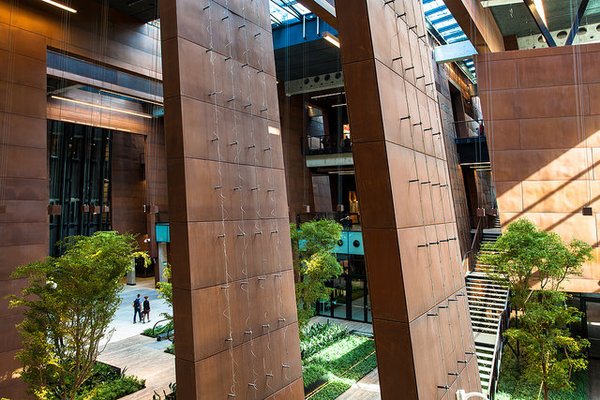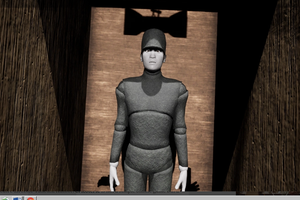Poland carves out place on world’s architectural map
The Szczecin Philharmonic, the Silesian Museum in Katowice and Warsaw’s POLIN Museum of the History of Polish Jews are deemed to be among the most distinguished works of modern architecture. While Polish architect studios continue to collect coveted projects, Poland also attracts the world’s most famous architects, who are taking on ambitious assignments across the country.
 The residents of Szczecin call it the “iceberg” due to its jagged roofline that resembles sharp ice blocks. The structure of the Mieczysław Karłowicz Philharmonic in Szczecin, designed by the Spanish Estudio Barrozi Veiga studio, resembles the Gothic-style townhouses that used to make up most of the port town’s architecture. The style was characteristic for trading hubs in Northern Europe during the late Middle Ages and the beginning of the early modern era. The virtually windowless, white construction composed of vertical aluminium blinds has filled the void left by the erstwhile Prussian Konzerthaus, whose ruin was demolished by Poland’s Socialist regime. In May 2015, the building was awarded with the Mies van der Rohe European Union Prize for Contemporary Architecture.
The residents of Szczecin call it the “iceberg” due to its jagged roofline that resembles sharp ice blocks. The structure of the Mieczysław Karłowicz Philharmonic in Szczecin, designed by the Spanish Estudio Barrozi Veiga studio, resembles the Gothic-style townhouses that used to make up most of the port town’s architecture. The style was characteristic for trading hubs in Northern Europe during the late Middle Ages and the beginning of the early modern era. The virtually windowless, white construction composed of vertical aluminium blinds has filled the void left by the erstwhile Prussian Konzerthaus, whose ruin was demolished by Poland’s Socialist regime. In May 2015, the building was awarded with the Mies van der Rohe European Union Prize for Contemporary Architecture.
Apart from the Szczecin Philharmonic, two other recent Polish structures made it on the list of Europe’s top 40 most important modern architectural constructions: the Silesian Museum in Katowice and the POLIN Museum of the History of Polish Jews in Warsaw (both made it to the final of the 2015 EU Prize for Contemporary Architecture). Earlier, the Silesian Museum – a modern complex built on the grounds of a former mine in Katowice with over 6,000m of subterranean exhibition space – won the 2014 Best Architects in Gold award, for its creative reinvention of public space. The POLIN Museum in Warsaw received its first international award in 2008, when it was bestowed with the Chicago Athenaeum World Architecture Award for best building. It has also collected many Polish distinctions, including the SARP 2013 Award of the Year and Polityka’s 2013 Architecture Award.
 On the grounds of the new Silesian Museum in Katowice, the shafthead frame of Warszawa II has been restored and old engine buildings are interspersed with harsh, glass blocks. Old and new has been intertwined. Post-industrial areas are increasingly becoming an area of interest for architects working in Poland. The reinvention of these complexes is starting to take on a new significance. This is also the case for old constructions that are being reconceptualised for cultural purposes. Creating original projects, using state-of-the-art technology and modern materials does not have to mean precluding the exhibition of Polish heritage. “It is encouraging to see how modern architects relate to the urban context, to the history of the place, to its legacy. A case in point is the old townhouse on Krakow’s Main Square, which is the headquarters of the International Culture Centre (ICC), but also the Raczynski Library in Poznan, says Prof. Jacek Purchla, an art historian, the founder of the ICC as well as the president of the Polish National Commission for UNESCO.
On the grounds of the new Silesian Museum in Katowice, the shafthead frame of Warszawa II has been restored and old engine buildings are interspersed with harsh, glass blocks. Old and new has been intertwined. Post-industrial areas are increasingly becoming an area of interest for architects working in Poland. The reinvention of these complexes is starting to take on a new significance. This is also the case for old constructions that are being reconceptualised for cultural purposes. Creating original projects, using state-of-the-art technology and modern materials does not have to mean precluding the exhibition of Polish heritage. “It is encouraging to see how modern architects relate to the urban context, to the history of the place, to its legacy. A case in point is the old townhouse on Krakow’s Main Square, which is the headquarters of the International Culture Centre (ICC), but also the Raczynski Library in Poznan, says Prof. Jacek Purchla, an art historian, the founder of the ICC as well as the president of the Polish National Commission for UNESCO.

The European Solidarity Centre awarded
In early December, the European Solidarity Centre in Gdansk received the Council of Europe Museum Prize for 2016. Vesna Marjanovic, the Council of Europe Parliamentary Assembly rapporteur on the prize, said that the museum is a “fascinating example of a cultural institution working towards promoting freedom and solidarity. The history that it covers and the institution’s programme make it a modern European forum (...).The Centre connects history with everyday life, creating a bridge between culture and democracy.” Testimony of this are the huge crowds of visitors: 390,000 people visited the European Solidarity Centre during its first year in its new headquarters.
The collapse of communism in 1989 and the systemic transformation that followed, created an opportunity for Polish architecture to develop – an opportunity that did not exist for many years. However, a real architectural boom started to take shape later, at the turn of the century. “It was only when Poland joined the European Union that unprecedented opportunities came about, making it possible to dedicate large funds towards creating infrastructure for cultural purposes. In recent years we have become a part of the world’s architectural market – designing constructions in Poland has become an attractive proposition for some of the world’s most famous architects, such as Daniel Liebeskind and Rainer Mahlamaki. This is somewhat of a revolution and an unprecedented civilizational leap! In the last decade, Poland has created a place for itself on the world’s architectural map,” says Prof. Purchla.
 The International Cultural Centre has compiled the most important architectural structures of recent years in an album entitled “Form Follows Freedom. Architecture for Culture in Poland 2000+”, published in English and Polish. “A lot of the projects presented in the book were exhibited at international competitions – these were opportunities which Polish architects made good use of. Polish architect studios were behind prestigious structures such as the European Solidarity Centre in Gdansk. These days, Polish architects work on the highest possible level, bringing a new quality and creativity,” says Prof. Purchla, who edited the publication together with Janusz Sepioł.
The International Cultural Centre has compiled the most important architectural structures of recent years in an album entitled “Form Follows Freedom. Architecture for Culture in Poland 2000+”, published in English and Polish. “A lot of the projects presented in the book were exhibited at international competitions – these were opportunities which Polish architects made good use of. Polish architect studios were behind prestigious structures such as the European Solidarity Centre in Gdansk. These days, Polish architects work on the highest possible level, bringing a new quality and creativity,” says Prof. Purchla, who edited the publication together with Janusz Sepioł.
“We based our selection not just on the concept behind the design, but also on geography. We really wanted to break away from the Warsaw-Krakow syndrome. That is why we show structures built in places such as Żelazowa Wola, Tarnów, Radom, Katowice, Lusławice and Opole,” he adds.
 Apart from the previously mentioned award-winning buildings and a growing list of internationally acclaimed designs in big Polish cities (such as the Wyspianski Pavilion, Tadeusz Kantor Museum in Krakow, the Cricoteka in Krakow as well as the Kubicki Arcades in Warsaw and the Katowice-based NOSPR headquarters), the book also contains other types of places, including the Frederic Chopin Part in Żelazowa Wola, the Krzysztof Penderecki European Centre for Music in Lusławice as well as the Votum of Alex Church in Tarnów.
Apart from the previously mentioned award-winning buildings and a growing list of internationally acclaimed designs in big Polish cities (such as the Wyspianski Pavilion, Tadeusz Kantor Museum in Krakow, the Cricoteka in Krakow as well as the Kubicki Arcades in Warsaw and the Katowice-based NOSPR headquarters), the book also contains other types of places, including the Frederic Chopin Part in Żelazowa Wola, the Krzysztof Penderecki European Centre for Music in Lusławice as well as the Votum of Alex Church in Tarnów.
The authors of the book say that Polish architecture has, at long-last, attracted international acclaim due to the constructions created for the cultural sphere over the last two decades. “Joining the European Union in 2004, and as a result of having access to EU funds, has helped us narrow the civilisation gap created between 1945 and 1989. (…) We can truly say that never before in Polish history has there been such as a good period, in terms of the number and the quality of architectural structures being built in our country,” says Ewa P. Porębska, editor-in-chief of “Architektura-murator” monthly.
BARBARA SUCHY
17.12.2015







